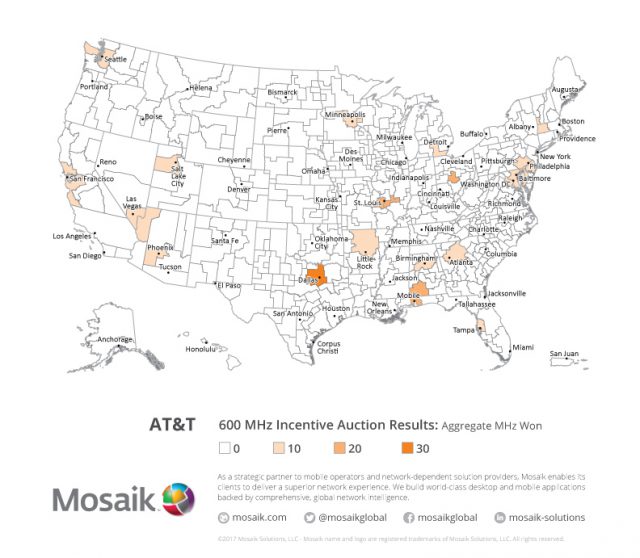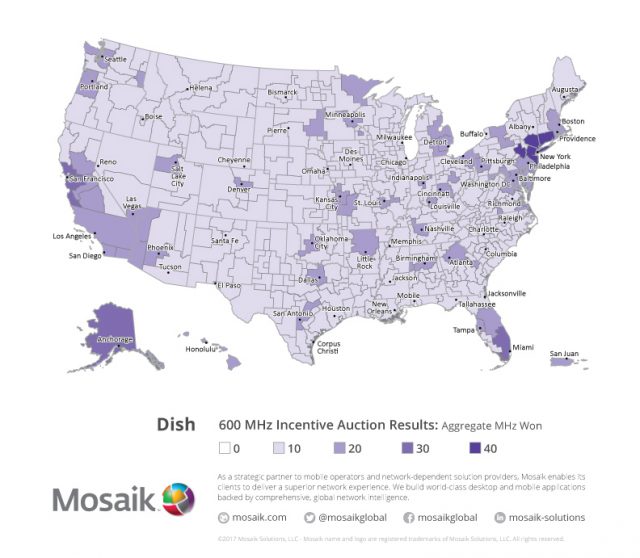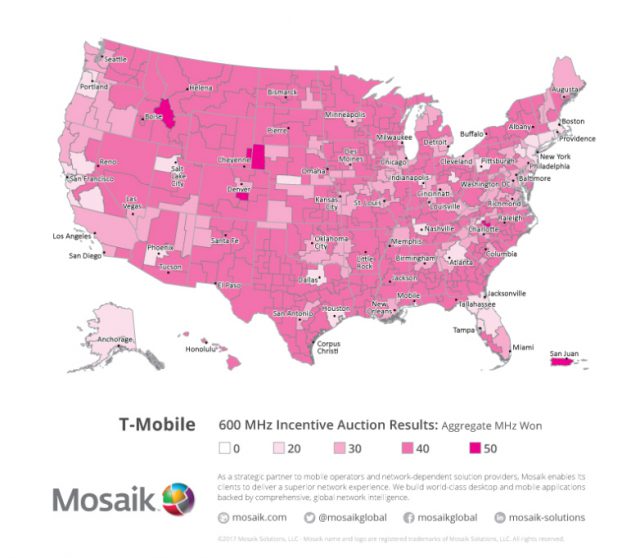Four large telecom companies won the bulk of the available licenses to operate their wireless services on the upcoming 600MHz band, once UHF TV channels occupying part of it vacate. But what exactly did AT&T, Comcast, Dish, and T-Mobile buy and where? Mosaik, a mapping firm, produced maps (courtesy Fierce Wireless) showing exactly where the four companies won 600MHz spectrum in the recent auction. The differences are striking. T-Mobile effectively won the right to launch new service almost everywhere in the country, in part because it acquired a huge number of cheap, low-demand licenses in largely rural areas.
Dish’s plans for its spectrum remain a complete mystery, while Comcast’s winning bids are entirely within areas where it provides cable service. AT&T, although already holding a large supply of low band frequencies, apparently needs more capacity in larger cities, and paid handsomely to get it.
AT&T
Most of AT&T’s winning bids cover larger cities where it already operates an extensive cellular network. Among the areas where AT&T can expand service: Philadelphia, Washington, Baltimore, St. Louis, Birmingham, Mobile, Tampa, Atlanta, Dallas, Phoenix, Las Vegas, San Francisco, Salt Lake City, Seattle, Minneapolis and Little Rock. But AT&T also grabbed licenses for rural western Massachusetts, central Ohio, and southern Michigan.
Comcast
Comcast’s winning bids consisted of 10MHz of spectrum, except in Nashville where it nabbed 20MHz. Comcast grabbed enough spectrum to cover every city in Florida except Tampa (where Charter provides cable service). The cable company focused heavily on east and west coast bids, winning spectrum across much of the Pacific Northwest, the Boston-NYC-DC corridor, and Illinois and Indiana. The only downside is that 10MHz is not a lot of spectrum to support a large wireless service, but then Comcast does not require that at this time, because it will rely primarily on a shared arrangement with Verizon Wireless to power Xfinity Mobile.
Dish Network
What Dish intends to do with its spectrum remains a complete mystery, but it grabbed a significant amount of it in New York City and its nearby suburbs, including Connecticut. It also won respectable quantities of frequencies in Alaska, California, Florida, Puerto Rico, Seattle and Portland, and several midwestern and south-central cities.
T-Mobile USA
T-Mobile published a similar map as part of its press package claiming victory in the spectrum auction. This map better highlights T-Mobile’s extensive spectrum wins in all 50 states and Puerto Rico. If T-Mobile uses it all, it will command similar coverage areas comparable to Verizon and AT&T. T-Mobile will manage this without any need to merge with anyone else, as AT&T and Sprint have historically argued in their past failed efforts to acquire T-Mobile.


 Subscribe
Subscribe



Regarding Dish, I’m hoping they are planning to offer wireless internet. We need more competition for home internet, and Dish would need coverage everywhere to suddenly offer service nationwide.